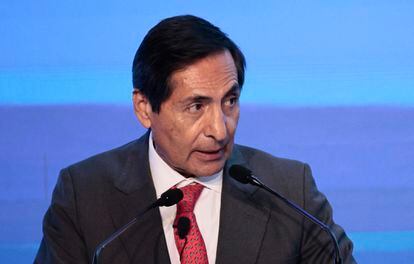Mexican Finance Secretary Rogelio Ramírez de la O speaks during BBVA's National Meeting of Regional Directors on June 6, in Mexico City, Mexico. Jose Mendez Jose Mendez (EFE)
Two years after interest rate hikes began in much of the world, public debt costs have skyrocketed for Mexico. The country also suffers from a surprising strengthening of its exchange rate, reducing the income it receives from oil exports paid in dollars. Despite all this, and unlike some peer countries in the Latin American region, the government has managed to contain its deficit.
According to the most recent public finance report, published by the Ministry of Finance, public debt fell between December last year and March of this year. The historical balance of the Public Sector Financial Requirements, the broadest measure of the government's public debt, went from 49.4% of the Gross Domestic Product (GDP) to 45.6% in that period. The Treasury estimates that by the end of this year, public debt will reach 50% of GDP.
This is a feat, if one takes into account that peer countries in the region, such as Chile, have had to let their deficit rise because they have increased their spending, considers Rodolfo Navarrete, director of analysis and investment strategy at Vector Casa de Bolsa. Policymakers underestimated how long interest rates would remain high and how strong the peso, which traded at 17.19 per dollar on Friday, would be. (The Mexican peso has appreciated 16% in the years of López Obrador's government.) "The shortfall, we estimate, will be about 50,000 million pesos. How are they going to solve it? Through a reduction in public spending. They will have to look for some item, something they stop doing, "explains Navarrete.
The discipline and fiscal orthodoxy of the Secretary of Finance, Rogelio Ramírez de la O, has earned him a ratification of the good credit rating at the international level. On June 16, Fitch Ratings reaffirmed the investment grade of Mexico, Latin America's second largest economy, and even adjusted its growth projection upwards. "Fitch projects that real GDP growth will slow modestly to 2.5% in 2023 from 3% seen in 2022, better than previously expected," the firm's statement said. "Mexico's rating is supported by a prudent macroeconomic policy framework, stable and sound external finances and a stable projection of the public debt-to-GDP ratio," Fitch specialists added.
Oil revenues, denominated in dollars, have seen a fall. According to an analysis by BBVA, the annual decrease in oil revenues contributed 3.1 percentage points to the real annual fall of 5.5% in total income between January and March of this year.
Seen from a longer perspective, López Obrador has allowed a moderate increase in the deficit, since he received the country with a debt level of 46% of GDP and the current level is estimated at 49.6%. His government has proclaimed itself as austere and this has been seen in the sharp cuts in education and health. BBVA points out that total spending was lower than scheduled in March of this year, partly because public health institutions reduced their spending, but also due to lower expenditures from the centralized public administration and parastatal energy companies, Petróleos Mexicanos and the Federal Electricity Commission.
For López Obrador, spending on social assistance has been a priority, but Navarrete, of Vector, does not expect this to increase before the presidential elections scheduled for July 2024. An increase in social aid would be a structural expense that could have a deterioration in public finances, since it represents a fixed expense that remains over time, says Navarrete. "I don't think he does anything," says the economist on the phone, "what the president has been saying lately is that he wants to put it in the Constitution, so that it is recognized and that nobody eliminates it. That doesn't mean I'm going to increase it."
Subscribe hereto the newsletter of EL PAÍS Mexico and receive all the informative keys of the news of this country
Subscribe to continue reading
Read without limits
Read more
I'm already a subscriber

